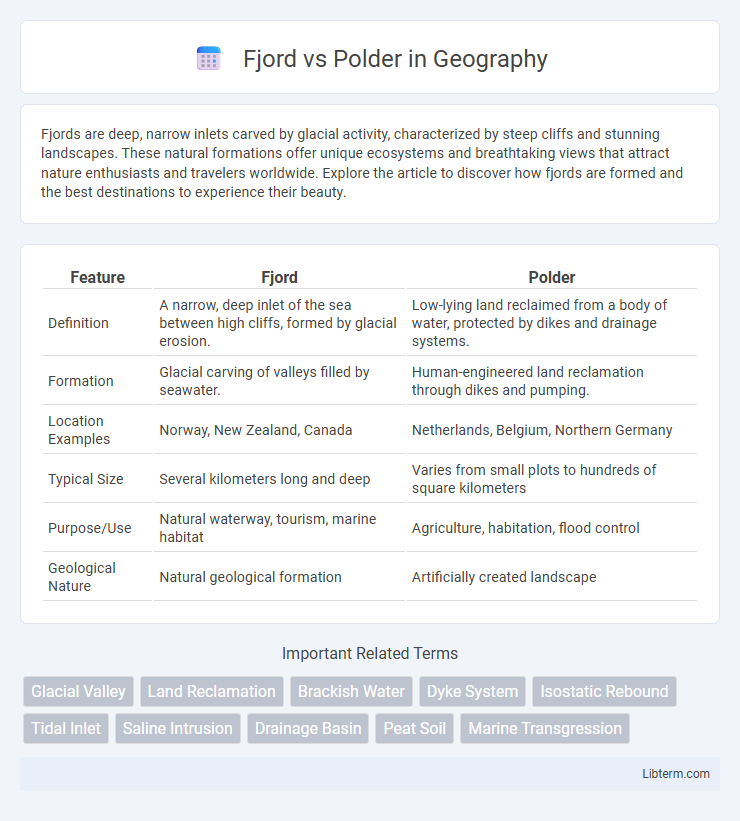Fjords are deep, narrow inlets carved by glacial activity, characterized by steep cliffs and stunning landscapes. These natural formations offer unique ecosystems and breathtaking views that attract nature enthusiasts and travelers worldwide. Explore the article to discover how fjords are formed and the best destinations to experience their beauty.
Table of Comparison
| Feature | Fjord | Polder |
|---|---|---|
| Definition | A narrow, deep inlet of the sea between high cliffs, formed by glacial erosion. | Low-lying land reclaimed from a body of water, protected by dikes and drainage systems. |
| Formation | Glacial carving of valleys filled by seawater. | Human-engineered land reclamation through dikes and pumping. |
| Location Examples | Norway, New Zealand, Canada | Netherlands, Belgium, Northern Germany |
| Typical Size | Several kilometers long and deep | Varies from small plots to hundreds of square kilometers |
| Purpose/Use | Natural waterway, tourism, marine habitat | Agriculture, habitation, flood control |
| Geological Nature | Natural geological formation | Artificially created landscape |
Introduction to Fjords and Polders
Fjords are deep, glacially carved valleys flooded by seawater, characterized by steep cliffs and formed through glacial erosion during ice ages. Polders are low-lying tracts of land reclaimed from bodies of water, such as lakes or seas, primarily through the use of dikes and drainage systems, commonly found in the Netherlands. Both fjords and polders illustrate human interaction with and adaptation to geological and environmental processes.
Defining Fjord: Origins and Characteristics
Fjords are deep, narrow, and elongated sea or lake inlets with steep land on three sides, formed by the glacial erosion of valleys during the last Ice Age. These geological formations exhibit unique characteristics such as U-shaped cross-sections, significant depth, and often contain brackish water due to freshwater inflow from rivers mixing with seawater. Originating primarily in regions with past glaciation, fjords are prominent in countries like Norway, New Zealand, and Canada, serving as key indicators of historical glacial activity.
Understanding Polders: Human-Made Landscapes
Polders are low-lying tracts of land reclaimed from bodies of water, primarily in the Netherlands, created through controlled drainage and dike construction to prevent flooding. These human-made landscapes function by managing water levels with pumps and canals, enabling agriculture and habitation on land previously submerged. Unlike fjords, which are natural deep glacial valleys filled with seawater, polders represent intentional modification of the environment for economic and settlement purposes.
Geological Formation: Fjord vs Polder
Fjords are deep, glacially carved valleys flooded by seawater, typically found in regions with past glaciation such as Norway and New Zealand. Polders are low-lying tracts of reclaimed land, mostly found in the Netherlands, created by draining wetlands or bodies of water and building dikes to prevent flooding. The geological formation of fjords results from glacial erosion, while polders originate from human-engineered land reclamation processes.
Key Differences in Location and Climate
Fjords are deep, glacially carved inlets found primarily in high-latitude regions such as Norway, characterized by cold, maritime climates with significant precipitation and mild summers. Polders are low-lying tracts of land reclaimed from the sea or inland water bodies, predominantly located in the Netherlands, featuring temperate climates with moderate rainfall and seasonal temperature variations. The key difference lies in fjords being natural, steep-sided coastal formations in cold, wet environments, while polders are human-engineered, flat landscapes in temperate zones adapted for agriculture and habitation.
Biodiversity and Ecosystem Comparison
Fjords, deep glacially carved inlets, support unique cold-water marine biodiversity such as cold-water corals, diverse fish species, and marine mammals adapted to nutrient-rich, stratified waters. Polders, reclaimed land areas from wetlands or seas, host diverse terrestrial and freshwater ecosystems, including marshlands, reed beds, and migratory bird habitats, creating valuable agricultural mosaics with significant ecological restoration potential. Both ecosystems provide crucial ecosystem services, but fjords emphasize aquatic biodiversity and carbon sequestration, whereas polders enhance habitat heterogeneity and flood regulation in modified landscapes.
Roles in Human Settlement and Agriculture
Fjords, carved by glacial activity, are narrow, deep inlets surrounded by steep cliffs, limiting large-scale agricultural development but offering rich marine resources that support fishing communities and maritime settlement. Polders, engineered reclaimed lands below sea level primarily in the Netherlands, enable extensive agricultural use through controlled water management systems, fostering dense human settlement and intensive farming. The contrasting roles highlight fjords as natural harbors facilitating fishing and trade, while polders represent human ingenuity in transforming aquatic environments into fertile farmland.
Economic and Touristic Significance
Fjords, such as Norway's Geirangerfjord, attract millions of tourists annually, boosting local economies through cruise tourism, fishing, and outdoor recreation industries. Polders, particularly in the Netherlands, showcase advanced land reclamation techniques that support intensive agriculture, real estate development, and flood protection, contributing significantly to regional economic stability. Both natural fjords and engineered polders serve as vital economic assets with distinct roles in tourism and sustainable resource management.
Environmental Challenges and Preservation
Fjords face environmental challenges such as rising sea temperatures, pollution, and habitat disruption affecting marine biodiversity, while polders encounter threats from soil subsidence, salinization, and increased flooding risks due to climate change and sea-level rise. Preservation efforts for fjords include strict regulation of industrial activities, monitoring water quality, and protecting native species to maintain the delicate ecosystems. In polders, sustainable water management, reinforcement of dikes, and measures to improve soil health are crucial to mitigate environmental stress and preserve agricultural productivity.
Conclusion: Fjord vs Polder in Perspective
Fjords are deep, glacially carved valleys flooded by seawater, characterized by steep cliffs and significant biodiversity, while polders are low-lying tracts of reclaimed land protected by dikes and managed through intricate water control systems. Fjords represent natural geological processes tied to glaciation and marine environments, whereas polders exemplify human engineering and land reclamation for agriculture and habitation. Understanding the distinction between fjords and polders highlights the contrast between natural landscape formation and anthropogenic landscape modification.
Fjord Infographic

 libterm.com
libterm.com